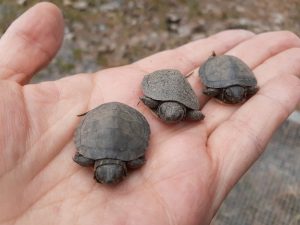Turtle crossings remain a concern even after peak nesting season from late spring into summer, but as fall approaches, turtle conservation groups are asking Ontario residents to pay special attention to hatchlings as they start to emerge from their nests.
Turtle hatchlings could start showing up anytime from now until the end of October depending on temperatures and weather patterns. Though it’s illegal to disturb or move turtle eggs without a permit, helping hatchlings from the area of their nest to their intended body of water is allowed and can help them survive, said Kelly Wallace, founder and managing director of the Think Turtle Conservation Initiative. Wallace and other conservationists are urging people across the province to watch for hatchlings and share information on how to help them survive.
“Keep an eye out for turtle hatchlings on roads, ATV trails, bike paths, driveways, parking areas, fire pits and/or building sites,” Wallace said in an online guide to helping hatchlings. “Please be sure to check your lawn and in gardens before seeing to any seasonal maintenance. If you spot one hatchling, check the area for the nest.”
The presence of one hatchling often means there are more, but they typically come out of the nest over a period of a few days. Wallace recommends that homeowners using nest protectors keep them out for up to two weeks after spotting a hatchling to ensure the turtles have time to emerge when they’re ready.
The hatchlings of some species like painted turtles and northern map turtles may even remain in the egg chamber until next spring in a practice known as overwintering. In general, the incubation period for turtle nests ranges from about 60 to 90 days after the female turtle lays her eggs, but the timeline depends on the species of turtle, location of the nest and other factors like sunlight, moisture and temperature.
“A warm summer can speed up the incubation period,” Wallace said. “A cooler summer and/or erratic temperatures and weather patterns like the ones we have been experiencing this turtle season could cause the hatchlings to be a little slower showing up, but in the end, we’re on turtle time.”
Bringing hatchlings to the nearest slow-moving body of water in the direction they were headed helps them bypass predators and other hazards, increasing their chance of survival. It’s important to handle hatchlings with care as their shells are soft and pliable, Wallace said, so use a gentle grip while making sure not to drop them.
After locating a body of water, look for a shallow area with vegetation or leafy debris, which can offer protective covering as well as resting sites for the hatchlings. Releasing them in open water leaves the hatchlings at risk to nearby predators or even drowning.

“The hatchling should be placed at the water’s edge or a shallow entry point where the hatchling can enter the water at their own pace,” Wallace said. “If a hatchling is put in water that is more than two inches deep to start off, with no vegetation to cling on to, the hatchling will have to tread water. A hatchling can only tread water for so long.”
If there are multiple hatchlings to release, it helps to spread them about 10 feet apart to reduce the chance of predators locating multiple hatchlings at once. Along with hatchlings, it’s important to keep an eye out for more turtle activity on the road as they seek out winter habitats from September to early November.
Regardless of age, reporting all turtle sightings, dead or alive, allows conservation organizations to better identify the distribution of various turtle species and the factors that impact their populations. Muskoka residents should call or text the hotline at Saving Turtles At Risk Today (S.T.A.R.T.), a local conservation initiative launched in 2013, to report sightings and to get help for injured turtles, which are brought to the Ontario Turtle Conservation Centre for care.
“Once treated and rehabilitated, the turtles are released back into their natural habitat at the point of origin where it is hoped they will live a long life and continue to reproduce for many decades,” Wallace said. “This is important to species recovery efforts and ensuring future generations of turtles.”
To report a sighting or to get help for an injured turtle, call or text the S.T.A.R.T. hotline at 705-955-4284. If you are interested in volunteering as a nest monitor, call or text the Think Turtle Conservation Initiative at 647-606-9537 for more information.
Click here for more information on how to help hatchlings.
Conservation Groups Ask Ontario Drivers To Be Careful On The Roads As Turtles Migrate








